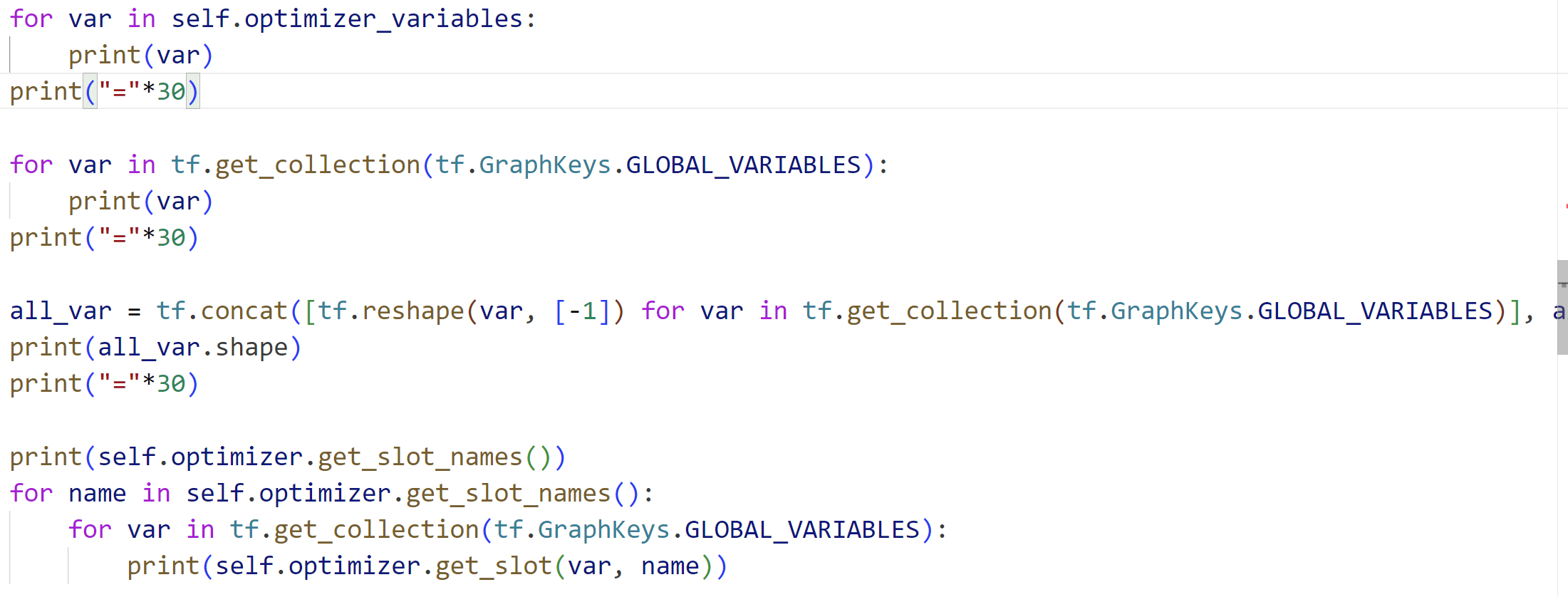在进行神经网络训练时需要使用的显存空间大小的预估——300MB的神经网络在训练时最少需要占用多大的显存空间
以Tensorflow为例。
=======================================
神经网络(TensorFlow举例)在GPU中训练时需要占用的内存大概有下面几部分组成:
1. TensorFlow的自身的计算库导入显存时所在内存,一般在session初始化时就会自动导入,这部分大小与TensorFlow的版本有关,这里大概估计普遍为450MB大小;
2. 神经网络的本身模型大小;
3. 优化器对神经网络模型进行优化时自身参数大小,一般一阶优化器的自身参数大小和神经网络模型本身大小相同,二阶优化器一般为模型本身大小的两倍(如:RMSProp优化器);
4. 神经网络前向计算时所产生的临时Tensor,这部分Tensor需要被临时保存,以便在反传计算梯度时使用,这部分Tensor的大小和模型的每一层结构形状有关(必须根据具体模型的每层形状来计算)也和具体的batch_size大小以及输入数据input_data的大小有关;
5. 神经网络向后性计算时被人为设定的一些负责监督运行状态或其他操作的Tensor,如:某些层的反传计算出的梯度进行正则化后或进行求mean/std/max/min等操作产生的Tensor,某些层前传时计算该层输出的一些统计Tensor(求mean/std/max/min等操作产生的Tensor);
--------------------------------------------
在估计一个模型在训练时所需的显存空间一般可以考虑将上面1, 2, 3部分的大小加总即可;4部分的大小难以计算,毕竟这个大小还和输入数据的大小和batch_size有关,而且每层的输出结构也是差异极大的;5部分的大小一般有限,可以不主要考虑。
PS:
这里需要说明一下,有些时候我们在跑模型训练的时候发现显存不够报错的时候我们可以通过调小batch_size的方式来解决,这时候我们就是通过调小第4部分显存大小来解决的;但是有些时候即使把batch_size设置为1也无法满足,那么就应该是第1,2,3部分所占显存空间已经超出了可用空间大小。
--------------------------------------------
关于第一部分显存大小,下面给出TensorFlow1.14版本的情况:


查看显存占用:

可以看到导入库后所占显存大小为104MB。
--------------------------------------------
关于第2, 3部分的大小,我们使用例子:(只给出项目中进行修改的文件)
https://gitee.com/devilmaycry812839668/paac/blob/master/actor_learner.py
我们在__init__函数中添加下面代码:
for var in self.optimizer_variables:
print(var)
print("="*30) for var in tf.get_collection(tf.GraphKeys.GLOBAL_VARIABLES):
print(var)
print("="*30) all_var = tf.concat([tf.reshape(var, [-1]) for var in tf.get_collection(tf.GraphKeys.GLOBAL_VARIABLES)], axis=0)
print(all_var.shape)
print("="*30) print(self.optimizer.get_slot_names())
for name in self.optimizer.get_slot_names():
for var in tf.get_collection(tf.GraphKeys.GLOBAL_VARIABLES):
print(self.optimizer.get_slot(var, name))

运行结果:
<tf.Variable 'local_learning_1/conv1_weights/OptimizerVariables:0' shape=(8, 8, 4, 16) dtype=float32_ref>
<tf.Variable 'local_learning_1/conv1_weights/OptimizerVariables_1:0' shape=(8, 8, 4, 16) dtype=float32_ref>
<tf.Variable 'local_learning_1/conv1_biases/OptimizerVariables:0' shape=(16,) dtype=float32_ref>
<tf.Variable 'local_learning_1/conv1_biases/OptimizerVariables_1:0' shape=(16,) dtype=float32_ref>
<tf.Variable 'local_learning_1/conv2_weights/OptimizerVariables:0' shape=(4, 4, 16, 32) dtype=float32_ref>
<tf.Variable 'local_learning_1/conv2_weights/OptimizerVariables_1:0' shape=(4, 4, 16, 32) dtype=float32_ref>
<tf.Variable 'local_learning_1/conv2_biases/OptimizerVariables:0' shape=(32,) dtype=float32_ref>
<tf.Variable 'local_learning_1/conv2_biases/OptimizerVariables_1:0' shape=(32,) dtype=float32_ref>
<tf.Variable 'local_learning_1/fc3_weights/OptimizerVariables:0' shape=(2592, 256) dtype=float32_ref>
<tf.Variable 'local_learning_1/fc3_weights/OptimizerVariables_1:0' shape=(2592, 256) dtype=float32_ref>
<tf.Variable 'local_learning_1/fc3_biases/OptimizerVariables:0' shape=(256,) dtype=float32_ref>
<tf.Variable 'local_learning_1/fc3_biases/OptimizerVariables_1:0' shape=(256,) dtype=float32_ref>
<tf.Variable 'local_learning_2/actor_output_weights/OptimizerVariables:0' shape=(256, 6) dtype=float32_ref>
<tf.Variable 'local_learning_2/actor_output_weights/OptimizerVariables_1:0' shape=(256, 6) dtype=float32_ref>
<tf.Variable 'local_learning_2/actor_output_biases/OptimizerVariables:0' shape=(6,) dtype=float32_ref>
<tf.Variable 'local_learning_2/actor_output_biases/OptimizerVariables_1:0' shape=(6,) dtype=float32_ref>
<tf.Variable 'local_learning_2/critic_output_weights/OptimizerVariables:0' shape=(256, 1) dtype=float32_ref>
<tf.Variable 'local_learning_2/critic_output_weights/OptimizerVariables_1:0' shape=(256, 1) dtype=float32_ref>
<tf.Variable 'local_learning_2/critic_output_biases/OptimizerVariables:0' shape=(1,) dtype=float32_ref>
<tf.Variable 'local_learning_2/critic_output_biases/OptimizerVariables_1:0' shape=(1,) dtype=float32_ref>
==============================
<tf.Variable 'local_learning_1/conv1_weights:0' shape=(8, 8, 4, 16) dtype=float32_ref>
<tf.Variable 'local_learning_1/conv1_biases:0' shape=(16,) dtype=float32_ref>
<tf.Variable 'local_learning_1/conv2_weights:0' shape=(4, 4, 16, 32) dtype=float32_ref>
<tf.Variable 'local_learning_1/conv2_biases:0' shape=(32,) dtype=float32_ref>
<tf.Variable 'local_learning_1/fc3_weights:0' shape=(2592, 256) dtype=float32_ref>
<tf.Variable 'local_learning_1/fc3_biases:0' shape=(256,) dtype=float32_ref>
<tf.Variable 'local_learning_2/actor_output_weights:0' shape=(256, 6) dtype=float32_ref>
<tf.Variable 'local_learning_2/actor_output_biases:0' shape=(6,) dtype=float32_ref>
<tf.Variable 'local_learning_2/critic_output_weights:0' shape=(256, 1) dtype=float32_ref>
<tf.Variable 'local_learning_2/critic_output_biases:0' shape=(1,) dtype=float32_ref>
<tf.Variable 'local_learning_1/conv1_weights/OptimizerVariables:0' shape=(8, 8, 4, 16) dtype=float32_ref>
<tf.Variable 'local_learning_1/conv1_weights/OptimizerVariables_1:0' shape=(8, 8, 4, 16) dtype=float32_ref>
<tf.Variable 'local_learning_1/conv1_biases/OptimizerVariables:0' shape=(16,) dtype=float32_ref>
<tf.Variable 'local_learning_1/conv1_biases/OptimizerVariables_1:0' shape=(16,) dtype=float32_ref>
<tf.Variable 'local_learning_1/conv2_weights/OptimizerVariables:0' shape=(4, 4, 16, 32) dtype=float32_ref>
<tf.Variable 'local_learning_1/conv2_weights/OptimizerVariables_1:0' shape=(4, 4, 16, 32) dtype=float32_ref>
<tf.Variable 'local_learning_1/conv2_biases/OptimizerVariables:0' shape=(32,) dtype=float32_ref>
<tf.Variable 'local_learning_1/conv2_biases/OptimizerVariables_1:0' shape=(32,) dtype=float32_ref>
<tf.Variable 'local_learning_1/fc3_weights/OptimizerVariables:0' shape=(2592, 256) dtype=float32_ref>
<tf.Variable 'local_learning_1/fc3_weights/OptimizerVariables_1:0' shape=(2592, 256) dtype=float32_ref>
<tf.Variable 'local_learning_1/fc3_biases/OptimizerVariables:0' shape=(256,) dtype=float32_ref>
<tf.Variable 'local_learning_1/fc3_biases/OptimizerVariables_1:0' shape=(256,) dtype=float32_ref>
<tf.Variable 'local_learning_2/actor_output_weights/OptimizerVariables:0' shape=(256, 6) dtype=float32_ref>
<tf.Variable 'local_learning_2/actor_output_weights/OptimizerVariables_1:0' shape=(256, 6) dtype=float32_ref>
<tf.Variable 'local_learning_2/actor_output_biases/OptimizerVariables:0' shape=(6,) dtype=float32_ref>
<tf.Variable 'local_learning_2/actor_output_biases/OptimizerVariables_1:0' shape=(6,) dtype=float32_ref>
<tf.Variable 'local_learning_2/critic_output_weights/OptimizerVariables:0' shape=(256, 1) dtype=float32_ref>
<tf.Variable 'local_learning_2/critic_output_weights/OptimizerVariables_1:0' shape=(256, 1) dtype=float32_ref>
<tf.Variable 'local_learning_2/critic_output_biases/OptimizerVariables:0' shape=(1,) dtype=float32_ref>
<tf.Variable 'local_learning_2/critic_output_biases/OptimizerVariables_1:0' shape=(1,) dtype=float32_ref>
==============================
(2033829,)
==============================
['momentum', 'rms']
<tf.Variable 'local_learning_1/conv1_weights/OptimizerVariables_1:0' shape=(8, 8, 4, 16) dtype=float32_ref>
<tf.Variable 'local_learning_1/conv1_biases/OptimizerVariables_1:0' shape=(16,) dtype=float32_ref>
<tf.Variable 'local_learning_1/conv2_weights/OptimizerVariables_1:0' shape=(4, 4, 16, 32) dtype=float32_ref>
<tf.Variable 'local_learning_1/conv2_biases/OptimizerVariables_1:0' shape=(32,) dtype=float32_ref>
<tf.Variable 'local_learning_1/fc3_weights/OptimizerVariables_1:0' shape=(2592, 256) dtype=float32_ref>
<tf.Variable 'local_learning_1/fc3_biases/OptimizerVariables_1:0' shape=(256,) dtype=float32_ref>
<tf.Variable 'local_learning_2/actor_output_weights/OptimizerVariables_1:0' shape=(256, 6) dtype=float32_ref>
<tf.Variable 'local_learning_2/actor_output_biases/OptimizerVariables_1:0' shape=(6,) dtype=float32_ref>
<tf.Variable 'local_learning_2/critic_output_weights/OptimizerVariables_1:0' shape=(256, 1) dtype=float32_ref>
<tf.Variable 'local_learning_2/critic_output_biases/OptimizerVariables_1:0' shape=(1,) dtype=float32_ref>
None
None
None
None
None
None
None
None
None
None
None
None
None
None
None
None
None
None
None
None
<tf.Variable 'local_learning_1/conv1_weights/OptimizerVariables:0' shape=(8, 8, 4, 16) dtype=float32_ref>
<tf.Variable 'local_learning_1/conv1_biases/OptimizerVariables:0' shape=(16,) dtype=float32_ref>
<tf.Variable 'local_learning_1/conv2_weights/OptimizerVariables:0' shape=(4, 4, 16, 32) dtype=float32_ref>
<tf.Variable 'local_learning_1/conv2_biases/OptimizerVariables:0' shape=(32,) dtype=float32_ref>
<tf.Variable 'local_learning_1/fc3_weights/OptimizerVariables:0' shape=(2592, 256) dtype=float32_ref>
<tf.Variable 'local_learning_1/fc3_biases/OptimizerVariables:0' shape=(256,) dtype=float32_ref>
<tf.Variable 'local_learning_2/actor_output_weights/OptimizerVariables:0' shape=(256, 6) dtype=float32_ref>
<tf.Variable 'local_learning_2/actor_output_biases/OptimizerVariables:0' shape=(6,) dtype=float32_ref>
<tf.Variable 'local_learning_2/critic_output_weights/OptimizerVariables:0' shape=(256, 1) dtype=float32_ref>
<tf.Variable 'local_learning_2/critic_output_biases/OptimizerVariables:0' shape=(1,) dtype=float32_ref>
None
None
None
None
None
None
None
None
None
None
None
None
None
None
None
None
None
None
None
None
通过结果我们可以知道,第2部分显存为模型的参数,即10个Tensor Variable所占,第3部分为20个针对模型参数的优化器参数,即20个Tensor Variable所占;其中模型参数(10个Variable)大小总共为(MB):

优化器的参数时模型参数的两倍,所以总共的Variable参数为3倍的模型参数(MB):

模型参数,10个Variable:
<tf.Variable 'local_learning_1/conv1_weights:0' shape=(8, 8, 4, 16) dtype=float32_ref>
<tf.Variable 'local_learning_1/conv1_biases:0' shape=(16,) dtype=float32_ref>
<tf.Variable 'local_learning_1/conv2_weights:0' shape=(4, 4, 16, 32) dtype=float32_ref>
<tf.Variable 'local_learning_1/conv2_biases:0' shape=(32,) dtype=float32_ref>
<tf.Variable 'local_learning_1/fc3_weights:0' shape=(2592, 256) dtype=float32_ref>
<tf.Variable 'local_learning_1/fc3_biases:0' shape=(256,) dtype=float32_ref>
<tf.Variable 'local_learning_2/actor_output_weights:0' shape=(256, 6) dtype=float32_ref>
<tf.Variable 'local_learning_2/actor_output_biases:0' shape=(6,) dtype=float32_ref>
<tf.Variable 'local_learning_2/critic_output_weights:0' shape=(256, 1) dtype=float32_ref>
<tf.Variable 'local_learning_2/critic_output_biases:0' shape=(1,) dtype=float32_ref>
优化器参数(二阶),20个Variable:
<tf.Variable 'local_learning_1/conv1_weights/OptimizerVariables:0' shape=(8, 8, 4, 16) dtype=float32_ref>
<tf.Variable 'local_learning_1/conv1_weights/OptimizerVariables_1:0' shape=(8, 8, 4, 16) dtype=float32_ref>
<tf.Variable 'local_learning_1/conv1_biases/OptimizerVariables:0' shape=(16,) dtype=float32_ref>
<tf.Variable 'local_learning_1/conv1_biases/OptimizerVariables_1:0' shape=(16,) dtype=float32_ref>
<tf.Variable 'local_learning_1/conv2_weights/OptimizerVariables:0' shape=(4, 4, 16, 32) dtype=float32_ref>
<tf.Variable 'local_learning_1/conv2_weights/OptimizerVariables_1:0' shape=(4, 4, 16, 32) dtype=float32_ref>
<tf.Variable 'local_learning_1/conv2_biases/OptimizerVariables:0' shape=(32,) dtype=float32_ref>
<tf.Variable 'local_learning_1/conv2_biases/OptimizerVariables_1:0' shape=(32,) dtype=float32_ref>
<tf.Variable 'local_learning_1/fc3_weights/OptimizerVariables:0' shape=(2592, 256) dtype=float32_ref>
<tf.Variable 'local_learning_1/fc3_weights/OptimizerVariables_1:0' shape=(2592, 256) dtype=float32_ref>
<tf.Variable 'local_learning_1/fc3_biases/OptimizerVariables:0' shape=(256,) dtype=float32_ref>
<tf.Variable 'local_learning_1/fc3_biases/OptimizerVariables_1:0' shape=(256,) dtype=float32_ref>
<tf.Variable 'local_learning_2/actor_output_weights/OptimizerVariables:0' shape=(256, 6) dtype=float32_ref>
<tf.Variable 'local_learning_2/actor_output_weights/OptimizerVariables_1:0' shape=(256, 6) dtype=float32_ref>
<tf.Variable 'local_learning_2/actor_output_biases/OptimizerVariables:0' shape=(6,) dtype=float32_ref>
<tf.Variable 'local_learning_2/actor_output_biases/OptimizerVariables_1:0' shape=(6,) dtype=float32_ref>
<tf.Variable 'local_learning_2/critic_output_weights/OptimizerVariables:0' shape=(256, 1) dtype=float32_ref>
<tf.Variable 'local_learning_2/critic_output_weights/OptimizerVariables_1:0' shape=(256, 1) dtype=float32_ref>
<tf.Variable 'local_learning_2/critic_output_biases/OptimizerVariables:0' shape=(1,) dtype=float32_ref>
<tf.Variable 'local_learning_2/critic_output_biases/OptimizerVariables_1:0' shape=(1,) dtype=float32_ref>
其中,这20个优化器参数在槽['momentum']中的有:
<tf.Variable 'local_learning_1/conv1_weights/OptimizerVariables_1:0' shape=(8, 8, 4, 16) dtype=float32_ref>
<tf.Variable 'local_learning_1/conv1_biases/OptimizerVariables_1:0' shape=(16,) dtype=float32_ref>
<tf.Variable 'local_learning_1/conv2_weights/OptimizerVariables_1:0' shape=(4, 4, 16, 32) dtype=float32_ref>
<tf.Variable 'local_learning_1/conv2_biases/OptimizerVariables_1:0' shape=(32,) dtype=float32_ref>
<tf.Variable 'local_learning_1/fc3_weights/OptimizerVariables_1:0' shape=(2592, 256) dtype=float32_ref>
<tf.Variable 'local_learning_1/fc3_biases/OptimizerVariables_1:0' shape=(256,) dtype=float32_ref>
<tf.Variable 'local_learning_2/actor_output_weights/OptimizerVariables_1:0' shape=(256, 6) dtype=float32_ref>
<tf.Variable 'local_learning_2/actor_output_biases/OptimizerVariables_1:0' shape=(6,) dtype=float32_ref>
<tf.Variable 'local_learning_2/critic_output_weights/OptimizerVariables_1:0' shape=(256, 1) dtype=float32_ref>
<tf.Variable 'local_learning_2/critic_output_biases/OptimizerVariables_1:0' shape=(1,) dtype=float32_ref>
其中,这20个优化器参数在槽['rms']中的有:
<tf.Variable 'local_learning_1/conv1_biases/OptimizerVariables:0' shape=(16,) dtype=float32_ref>
<tf.Variable 'local_learning_1/conv2_weights/OptimizerVariables:0' shape=(4, 4, 16, 32) dtype=float32_ref>
<tf.Variable 'local_learning_1/conv2_biases/OptimizerVariables:0' shape=(32,) dtype=float32_ref>
<tf.Variable 'local_learning_1/fc3_weights/OptimizerVariables:0' shape=(2592, 256) dtype=float32_ref>
<tf.Variable 'local_learning_1/fc3_biases/OptimizerVariables:0' shape=(256,) dtype=float32_ref>
<tf.Variable 'local_learning_2/actor_output_weights/OptimizerVariables:0' shape=(256, 6) dtype=float32_ref>
<tf.Variable 'local_learning_2/actor_output_biases/OptimizerVariables:0' shape=(6,) dtype=float32_ref>
<tf.Variable 'local_learning_2/critic_output_weights/OptimizerVariables:0' shape=(256, 1) dtype=float32_ref>
<tf.Variable 'local_learning_2/critic_output_biases/OptimizerVariables:0' shape=(1,) dtype=float32_ref>
判断优化器中参数是否可以训练:



查询结果:

------------------------------------------------------
可以看到,在例子中,第2部分和第3部分的显存大小共为:7.7584MB
而第1部分的显存占用为104MB,那么我们运行下例子所在的项目,看下总共在训练时占用显存大小:

由此我们可以知道,即使是一些模型大小特别小的模型(模型参数加优化器参数共7.7584MB)也可以在运行时占用大量显存,这时候所占用显存的主要为第4部分和第5部分所占,我们将batch_size设置为1,然后再看下:
此时项目启动命令:python3 train.py -g pong -df logs/ -ec 1 -ew 1 --max_local_steps 1

PS:
通过这个例子,我们可以知道,即使一个模型特别小(优化器参数也随之很小,共7.7584MB),但是计算过程中所需导入显存的lib库和训练过程中产生的临时Tensor、用于检测的Tensor所占的空间大小也可以是很大的,甚至是近百倍于模型参数大小;所以说一个模型在训练过程中所需最小显存空间并不由模型参数大小所完全决定,有时候训练过程中的临时Tensor大小会大于模型参数大小;通过修改batch_size可以缩小训练过程中的临时Tensor大小,但是这个缩小程度毕竟有限,例子中通过减小batch size所获增加的空余显存空间为832-592=240MB。
------------------------------------------------------
RMSProp优化器:

参考:
https://www.coder.work/article/93009
=======================================
在进行神经网络训练时需要使用的显存空间大小的预估——300MB的神经网络在训练时最少需要占用多大的显存空间的更多相关文章
- 交叉熵代价函数——当我们用sigmoid函数作为神经元的激活函数时,最好使用交叉熵代价函数来替代方差代价函数,以避免训练过程太慢
交叉熵代价函数 machine learning算法中用得很多的交叉熵代价函数. 1.从方差代价函数说起 代价函数经常用方差代价函数(即采用均方误差MSE),比如对于一个神经元(单输入单输出,sigm ...
- 用SQL语句实现:当A列大于B列时选择A列否则选择B列,当B列大于C列时选择B列否则选择C列。
数据库中有A B C三列,用SQL语句实现:当A列大于B列时选择A列否则选择B列,当B列大于C列时选择B列否则选择C列. 方法一: select (case when a>b then a el ...
- 设置一个div网页滚动时,使其固定在头部,当页面滚动到距离头部300px时,隐藏该div,另一个div在底部,此时显示;当页面滚动到起始位置时,头部div出现,底部div隐藏
设置一个div网页滚动时,使其固定在头部,当页面滚动到距离头部300px时,隐藏该div,另一个div在底部,此时显示: 当页面滚动到起始位置时,头部div出现,底部div隐藏 前端代码: <! ...
- 在mvc返回JSON时出错:序列化类型为“System.Data.Entity.DynamicProxies.Photos....这个会的对象时检测到循环引用 的解决办法
在MVC中返回JSON时出错,序列化类型为“System.Data.Entity.DynamicProxies.Photos....这个会的对象时检测到循环引用. public ActionResul ...
- 题目:企业发放的奖金根据利润提成。 利润(I)低于或等于10万元时,奖金可提10%; 利润高于10万元,低于20万元时,低于10万元的部分按10%提成,高于10万元的部分,可可提成7.5%; 20万到40万之间时,高于20万元的部分,可提成5%; 40万到60万之间时高于40万元的部分,可提成 3%; 60万到100万之间时,高于60万元的部分,可提成1.5%; 高于100万元时,超过
题目:企业发放的奖金根据利润提成. 利润(I)低于或等于10万元时,奖金可提10%: 利润高于10万元,低于20万元时,低于10万元的部分按10%提成,高于10万元的部分,可可提成7.5%: 20万到 ...
- SQL语句实现:当A列大于B列时选择A列否则选择B列,当B列大于C列时选择B列否则选择C列
分享一道今天的面试题:SQL语句实现:数据库中有A B C三列,当A列大于B列时选择A列否则选择B列,当B列大于C列时选择B列否则选择C列 第一种:使用case when...then...else ...
- 代码实现:企业发放的奖金根据利润提成。利润(I)低于或等于10万元时,奖金可提10%; 利润高于10万元,低于20万元时,低于10万元的部分按10%提成,高于10万元的部分,可可提成7.5%; 20万到40万之间时,高于20万元的部分,可提成5%;40万到60万之间时高于40万元的部分,可提成3%; 60万到100万之间时,高于60万元的部分,可提成1.5%,高于100万元时,超过100万元
import java.util.Scanner; /* 企业发放的奖金根据利润提成.利润(I)低于或等于10万元时,奖金可提10%: 利润高于10万元,低于20万元时,低于10万元的部分按10%提成 ...
- iOS开发之UIImage在压缩时失真问题,压缩图片的大小
今天遇到UIImage在压缩时失真问题,压缩图片的大小图片模糊 错误的方案 /** * 压缩图片 * image:将要压缩的图片 size:压缩后的尺寸 */ -(UIImage*) OriginIm ...
- 深度学习原理与框架-猫狗图像识别-卷积神经网络(代码) 1.cv2.resize(图片压缩) 2..get_shape()[1:4].num_elements(获得最后三维度之和) 3.saver.save(训练参数的保存) 4.tf.train.import_meta_graph(加载模型结构) 5.saver.restore(训练参数载入)
1.cv2.resize(image, (image_size, image_size), 0, 0, cv2.INTER_LINEAR) 参数说明:image表示输入图片,image_size表示变 ...
- 【神经网络与深度学习】Caffe使用step by step:使用自己数据对已经训练好的模型进行finetuning
在经过前面Caffe框架的搭建以及caffe基本框架的了解之后,接下来就要回到正题:使用caffe来进行模型的训练. 但如果对caffe并不是特别熟悉的话,从头开始训练一个模型会花费很多时间和精力,需 ...
随机推荐
- SQL SERVER 2012的安装
1.将光盘镜像用虚拟光驱加载(WIN10自带虚拟光驱) 2.双击setup.exe 3.选择"安装"-"全新 SQL Server 独立安装或向现有安装添加功能" ...
- Invalid revision: 3.18.1-g262b901-dirty CMake Error: CMake was unable to find a build program corresponding to "Ninja".
一次在GitHub上找到的项目,本想编译运行下,但报如下的问题 错误一 Invalid revision: 3.18.1-g262b901-dirty 解决办法: 这是因为版本不对应,可在local. ...
- 08-Linux计划任务
什么是计划任务 周期性或者定时执行某个命令或者脚本. crontab 安装 yum install crontabs #安装crontabs systemctl enable crond #开机启动 ...
- VSCode因网络问题导致下载更新/扩展出错
VSCode因网络问题导致下载更新/扩展出错 可尝试方法: 问题0: VSCode出现网络问题排查方法? 法1: 启动时加上选项 --log-net-log=netlog.json ...
- Linux 内核:设备树中的特殊节点
Linux 内核:设备树中的特殊节点 背景 在解析设备树dtb格式的时候,发现了这个,学习一下. 参考: https://blog.csdn.net/weixin_45309916/article/d ...
- Fake权限验证小例子
前言 关于本地测试如何进行Fake权限验证 正文 在我们使用swagger调试本地接口的时候,我们常常因为每次需要填写token而耽误工作,不可能每次调试的时候都去本地测试环境请求一个token进行验 ...
- 【价格全面下调】一片含税79元,双核A7@1.2GHz,-40℃~85℃真工业级!
自9个月前,创龙科技全志T113-i核心板(SOM-TLT113)推出之后,受到广大工业用户的高度关注,且超过300家企业已选用创龙科技T113-i核心板用于终端产品开发. 为了让更多用户轻松选择T1 ...
- Spring注解之生命周期@PostConstruct和@PreDestroy
****### 简介 从Java EE5规范开始,Servlet增加了两个影响Servlet生命周期的注解(Annotation):@PostConstruct和@PreConstruct. 这两个注 ...
- 树莓派安装OpenCv
树莓派安装OpenCv 更换树莓派软件源 我们选择将树莓派的软件源切换到清华大学镜像站,据笔者亲测,通过此站可以顺利安装openCV. 切换软件源需要修改两个软件源配置文件的内容. 第一个需要修改是「 ...
- P1754
球迷购票问题 题意描述 盛况空前的足球赛即将举行.球赛门票售票处排起了球迷购票长龙. 按售票处规定,每位购票者限购一张门票,且每张票售价为50元.在排成长龙的球迷中有N个人手持面值50元的钱币,另有N ...
